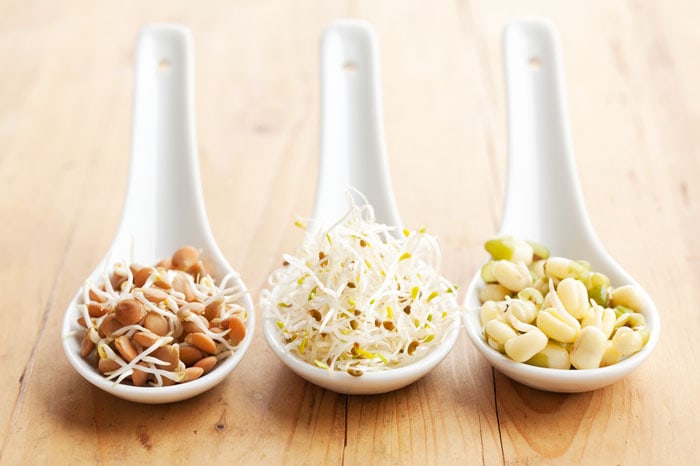
Written By: Sofia Layarda, MPH
Title: Master of Public Health
Alumni: University of California, Berkeley
Last Updated on:

Sprouting grains and seeds seems to be all the rage these days. What is the real deal with sprouting, and is there a way to do this at home?

Table of Contents
Why would anyone sprout at home? Dry seeds become fresh sprouts in a matter of days, so if you have access to good quality, clean seeds suitable for sprouting, it becomes possible to enjoy fresh sprouts year-round without having to garden. Sprouting has also been shown to alter the nutrient content of seeds beneficially, making certain minerals such as iron, calcium, and zinc more bioavailable through decreased phytic acid, which can inhibit absorption of minerals. Other studies have found:
While we typically think of the mung bean sprouts sold in the produce cooler section of the supermarket, almost any whole grain or seed can be sprouted. These include:
However, seeds from the nightshade family of plants such as tomato, peppers, and eggplant should not be consumed as sprouts.
Sprouting generally involves soaking or rinsing the dry, raw seeds and then putting them in a container that allows drainage (to prevent rotting or mold). The simplest way to do this is in an inverted glass jar with a breathable fabric sheeting over the mouth. The seeds are typically rinsed twice a day and left at room temperature, either inside a dark place or with some sun, depending on the plant. Within days, sprouts will begin to form, where the seeds will show little “tails.” Most sprouted seeds are ready for consumption within 3-5 days.
Generally, the two main factors that help seeds germinate or sprout are warmth and humidity. Unfortunately, these are also factors that favor the growth of unwanted organisms such as bacteria. Contamination can exist in the dry, unsprouted seed, or can be introduced during the sprouting process. To minimize the likelihood of bacterial contamination, you should ideally have a clear idea where the seeds used for sprouting came from, and that they were transported and handled in a way that minimizes the risk of cross-contamination. Health agencies recommend that you cook sprouted food thoroughly before eating. This is not always realistic, depending on the type of sprout you have on hand – alfalfa sprouts, for example, are intended to be consumed raw because they are so thin and fragile. Studies have looked at different methods of cleaning the seeds before sprouting, through the use of high-pressure or high-temperature water spray or rinse.
While consuming sprouted seeds is not a silver bullet for whatever ails us, it can be a beneficial and interesting way of consuming more whole grains, seeds, or lentils and experiencing their flavor and texture in a different way. If you choose to sprout your own seeds at home, be sure to take the precautions listed above to minimize the likelihood of food-borne illnesses.
Alumni: University of California, Berkeley – Sofia believes in bringing back fun and pleasure into everyday eating. She loves cooking, and is constantly experimenting with ingredients, creating recipes and trying them out on family and friends. Her latest interest lies in finding realistic and practical ways of environmentally-friendly food/eating habits.
beans, home cooking, legumes, seeds, sprouting, vegetable gardening, whole grains